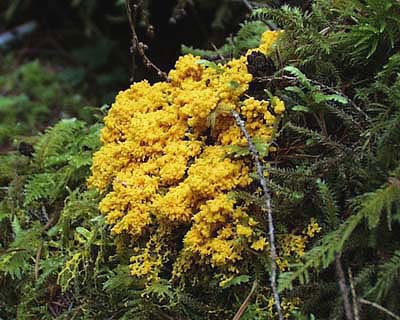Info:
Slime mold (or slime mould) is a broad term describing fungus-like organisms that use spores to reproduce. They were formerly classified as fungi, but are no longer considered part of this kingdom.
Their common name refers to part of some of these organisms' lifecycles where they can appear as gelatinous "slime". This is mostly seen with the myxomycetes, which are the only macroscopic slime molds.
Slime molds have been found all over the world and feed on microorganisms that live in any type of dead plant material. For this reason, these organisms are usually found in soil, lawns, and on the forest floor, commonly on deciduous logs. However, in tropical areas they are also common on inflorescences, fruits and in aerial situations (e.g., in the canopy of trees). In urban areas, they are found on mulch or even in the leaf mold in gutters. One of the most commonly encountered slime molds, both in nature in forests in the temperate zones of the earth as well as in classrooms and laboratories is the yellow Physarum polycephalum.
Most slime mold are smaller than a few centimetres, but some species may reach sizes of up to several square meters and masses of up to 30 grams. Many have striking colours such as yellow, brown and white.
Life cycle:
They begin life as amoeba-like cells. These unicellular amoebae are commonly haploid and multiply if they encounter their favorite food, bacteria. These amoebae can mate if they encounter the correct mating type and form zygotes which then grow into plasmodia. These contain many nuclei without cell membranes between them, which can grow to be meters in size. One variety is often seen as a slimy yellow network in and on rotting logs. The amoebae and the plasmodia engulf microorganisms. The plasmodium grows into an interconnected network of protoplasmic strands.
Slime mold (or slime mould) is a broad term describing fungus-like organisms that use spores to reproduce. They were formerly classified as fungi, but are no longer considered part of this kingdom.
Their common name refers to part of some of these organisms' lifecycles where they can appear as gelatinous "slime". This is mostly seen with the myxomycetes, which are the only macroscopic slime molds.
Slime molds have been found all over the world and feed on microorganisms that live in any type of dead plant material. For this reason, these organisms are usually found in soil, lawns, and on the forest floor, commonly on deciduous logs. However, in tropical areas they are also common on inflorescences, fruits and in aerial situations (e.g., in the canopy of trees). In urban areas, they are found on mulch or even in the leaf mold in gutters. One of the most commonly encountered slime molds, both in nature in forests in the temperate zones of the earth as well as in classrooms and laboratories is the yellow Physarum polycephalum.
Most slime mold are smaller than a few centimetres, but some species may reach sizes of up to several square meters and masses of up to 30 grams. Many have striking colours such as yellow, brown and white.
Life cycle:
They begin life as amoeba-like cells. These unicellular amoebae are commonly haploid and multiply if they encounter their favorite food, bacteria. These amoebae can mate if they encounter the correct mating type and form zygotes which then grow into plasmodia. These contain many nuclei without cell membranes between them, which can grow to be meters in size. One variety is often seen as a slimy yellow network in and on rotting logs. The amoebae and the plasmodia engulf microorganisms. The plasmodium grows into an interconnected network of protoplasmic strands.
Within each protoplasmic strand the cytoplasmic contents rapidly stream. If one strand is carefully watched for about 50 seconds the cytoplasm can be seen to slow, stop, and then reverse direction. The streaming protoplasm within a plasmodial strand can reach speeds of up to 1.35 mm per second which is the fastest rate recorded for any micro-organism. Migration of the plasmodium is accomplished when more protoplasm streams to advancing areas and protoplasm is withdrawn from rear areas. When the food supply wanes, the plasmodium will migrate to the surface of its substrate and transform into rigid fruiting bodies. The fruiting bodies or sporangia are what we commonly see, they superficially look like fungi or molds but are not related to the true fungi. These sporangia will then release spores which hatch into amoebae to begin the life cycle again.





0 comments:
Post a Comment